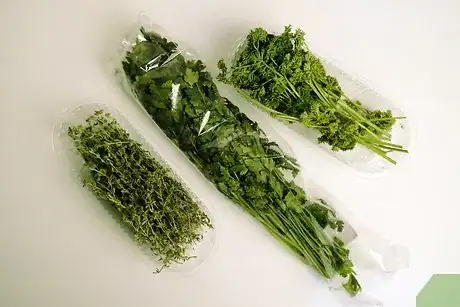This article was co-authored by Sasha Reyes. Chef Sasha Reyes is the Executive Chef and Owner of Artisan Personal Chefs. With over 20 years of food industry experience, she specializes in private dinner parties, custom sports nutrition plans for professional athletes, and cooking lessons. Chef Reyes graduated from Arizona Culinary Institute in 2011 with a degree in Culinary Arts, Baking, and Restaurant Management.
wikiHow marks an article as reader-approved once it receives enough positive feedback. In this case, several readers have written to tell us that this article was helpful to them, earning it our reader-approved status.
This article has been viewed 234,214 times.
Soup can easily be spoiled by too much salt. Whether you are trying a new recipe that didn't work out, or disappointed by overly-salted soup that you bought, there are plenty of ways to correct the flavor. It can be as simple as adding more liquid, a dash of vinegar, or a spoonful of sugar. Or, you can mix up another batch of soup with no salt to have a double batch of flavor-balanced soup. Taste as you go and avoid ingredients with too much salt when making homemade soup to get the perfect blend.
Steps
Diluting the Soup
-
1Dilute brothy soup with water or stock. The most reliable solution for fixing salty soup is adding more liquid. Add a little bit of water or stock at a time and then bring the soup to a simmer. This reduces the concentration of salt in the broth.[1]
- If you are using stock to dilute your soup, make sure it is unsalted.
- Alternatively, you can strain off the salty stock so that you retain the ingredients. Then, add fresh, unsalted stock and bring the soup to a simmer again.[2]
-
2Add cream or milk to dairy-based soup. Add a splash of milk or cream for dairy-based soups. Although water or stock would also dilute the salt, adding milk or cream retains some of the richness and flavor of the soup.[3]
- Don't worry about diluting the flavor of the soup. You can always add more seasoning.
Advertisement -
3Mix the salty soup with a batch of unsalted soup. Make another batch of soup with no salt. Then, mix the two soups together. You'll end up with a double batch of flavor-balanced soup.[4]
- Try freezing any soup you have leftover by putting it into a Ziploc bag and then leaving it in the freezer. Then, you can warm this soup up and use it if you ever need to dilute a salty soup!
Adding Ingredients
-
1Put some celery, onion, or leeks in your soup to freshen it up. These ingredients will help clean up the flavor and correct saltiness. Chop them up and add them to your soup, then allow them to cook for around 30 minutes. The amount depends on your tastes. This works best for brothy soup that already has a lot of vegetables.[5]
- You can also try some fresh, crushed tomatoes.
- Keep in mind that adding new ingredients will change the flavor of your soup.
-
2Add a dash of acid to trick the tongue. Balance out the salty flavor by adding something sour. Try adding an acid such as lemon or lime juice, vinegar, or wine which will obscure the salty taste. This trick works well with any kind of soup or stew.[6]
- Add a little bit of acid at a time and taste as you go.
-
3Mix in 2-3 teaspoons (8-12 g) of sugar to sweeten the soup. If your soup is just a little bit too salty, balance out the flavor with a small amount of sugar. This will help take the edge off the saltiness. Make sure to add a little at a time and taste as you go.[7]
- You can also try a dash of brown sugar, honey, or maple syrup if you prefer.
-
4Add a starch to absorb the salt. Adding a starchy food like a potato, rice, or pasta is a commonly-given suggestion for overly salty soup, but it won't make a huge difference. Try slicing a potato into small pieces and simmering them in the soup for 30 minutes to subtly reduce the salty taste of the soup. This works well with brothy soups rather than stews, since the starch can soak up more liquid.[8]
- Combine this suggestion with others to make a bigger difference.
- You can boil the vegetables for a soup depending on the vegetable you are using.
- A soft vegetable such as asparagus or peas needs a lower cooking time than a hard vegetable like a root vegetable such as a carrot.
- The general rule of thumb is to boil the vegetables until they are tender.
Preventing Salty Soup
-
1Salt your soup after boiling it instead of before. Avoid salting your soup before cooking it. Once the soup boils, the liquid will evaporate off and the remaining soup will be saltier than you intended. Salting at the end of cooking means the flavor will taste the same when you add the salt as when you serve the soup.[9]
- The longer soup boils, the saltier it will become.
-
2Add a little bit of salt after incorporating each ingredient. Rather than putting all of the salt in at once, add salt about 1/4 tsp (1 g) at a time, tasting in between to get it just right. This will help all of the ingredients be evenly seasoned.[10]
- Taste the soup as you cook it.
-
3Avoid adding salt if the soup contains ingredients high in sodium. If the soup already has bacon, ham, or other salty ingredients it might not need any salt at all. Cooking with cheese also means you don't have to add much salt.[11]
- If you are cooking with canned foods, like beans, try rinsing them before adding them in. They are preserved with salt and rinsing them first can reduce the amount of sodium you add into the soup.
-
4Use fresh herbs rather than salt to season your soup. Rather than relying entirely on salt for flavor, try adding some fresh herbs. Plus, fresh herbs pack a lot of flavor without adding any sodium to your soup. Try adding 1 1/2 tsp (6 g) of parsley, thyme, oregano, or rosemary for a fresh flavor.[12]
- You can also used dried herbs or spices, if you don't have any fresh ones on hand.
- Keep in mind that dried herbs or herb blends can contain salt.
-
5Replace salted butter with unsalted butter in your recipe. If your soup recipe calls for sautéing vegetables in butter, for instance, make sure to use unsalted butter. This will reduce the amount of salt in your soup overall.[13]
- You can also swap out butter for olive oil for a healthier option.
-
6Use low-sodium broth to keep the soup from being too salty. Stock can taste bland without salt, but it is the perfect blank slate for you to add your own seasoning. Using broth that is pre-salted makes it easier to over-salt your soup.[14]
- When making homemade stock, don't add salt. You can add salt later when you are making soup.
- It is especially important to use a stock containing low sodium when other ingredients already have high amounts of salt.
-
7Let people salt their own soup to suit their tastes. People often vary in their preferences for saltiness. Hold off on adding extra seasoning during the cooking process and let people add their own salt at the table.
Community Q&A
-
QuestionMy friend gave me potato soup that is terribly salty. I believe it has milk in it. Any suggestions?
 Community AnswerYou can try adding more liquid to it, cream or water, to dilute the salt. However, you may also be diluting flavor, so if you do so, use a small bit at a time and taste.
Community AnswerYou can try adding more liquid to it, cream or water, to dilute the salt. However, you may also be diluting flavor, so if you do so, use a small bit at a time and taste.
References
- ↑ https://www.thekitchn.com/soup-too-salty-5-tips-for-fixing-it-making-sure-it-doesnt-happen-again-178694
- ↑ https://saramoulton.com/2012/07/saras-kitchen-revelations-oversalted-it-there-is-one-solution/
- ↑ https://www.thekitchn.com/soup-too-salty-5-tips-for-fixing-it-making-sure-it-doesnt-happen-again-178694
- ↑ https://thetakeout.com/how-do-you-correct-over-salted-food-1826576388
- ↑ https://thetakeout.com/how-do-you-correct-over-salted-food-1826576388
- ↑ https://www.epicurious.com/expert-advice/how-to-save-food-thats-too-salty-article
- ↑ https://thetakeout.com/how-do-you-correct-over-salted-food-1826576388
- ↑ https://www.thekitchn.com/can-a-potato-really-fix-a-toosalty-soup-putting-tips-to-the-test-in-the-kitchn-214650
- ↑ https://www.thekitchn.com/soup-too-salty-5-tips-for-fixing-it-making-sure-it-doesnt-happen-again-178694
- ↑ https://thetakeout.com/how-do-you-correct-over-salted-food-1826576388
- ↑ https://www.epicurious.com/expert-advice/how-to-save-food-thats-too-salty-article
- ↑ https://www.tasteofhome.com/article/cut-sodium-in-soup/
- ↑ https://www.tasteofhome.com/article/cut-sodium-in-soup/
- ↑ https://www.tasteofhome.com/article/cut-sodium-in-soup/
About This Article
To fix salty soup, try adding some vinegar, lemon juice, or wine to the soup so the acidity balances out the saltiness. You can also dilute the soup using water, juice, or stock so that it doesn't taste as salty. If you're making a hearty soup, try adding something starchy, like rice, potatoes, or noodles, which will absorb some of the salt. Or, you can sprinkle a few teaspoons of sugar into the soup to make it sweeter and less salty. To learn how to prevent soup from getting too salty in the first place, scroll down!
























































